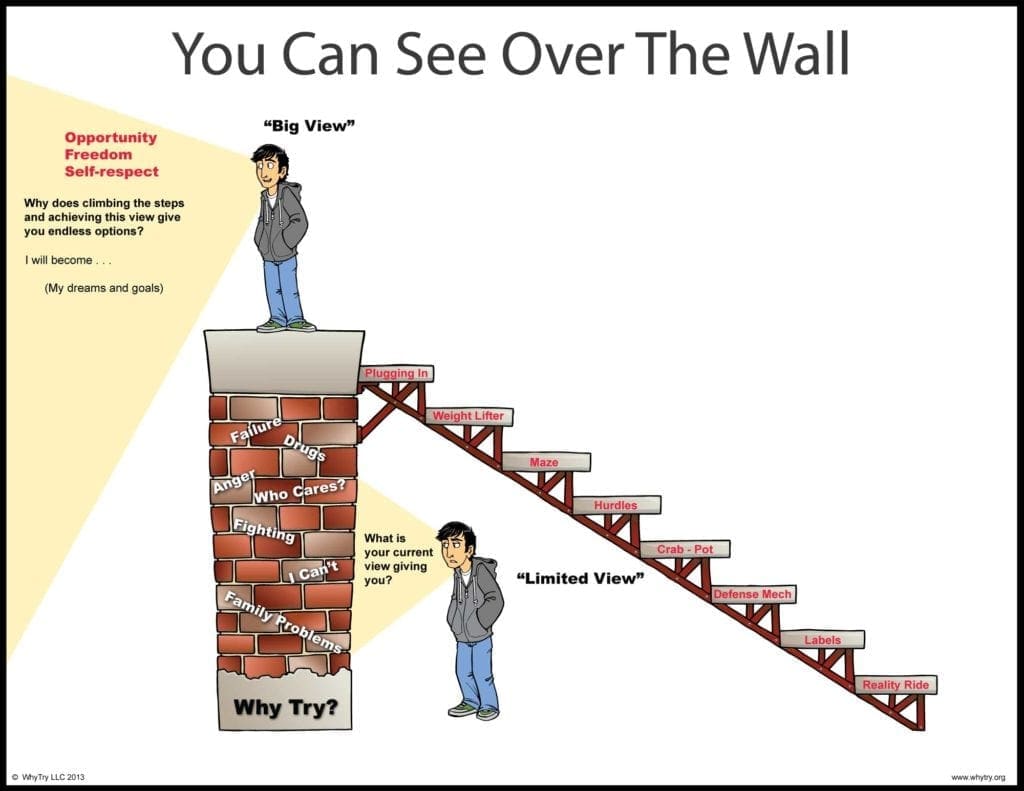Dropout Prevention

An Effective Dropout Prevention Approach
2.1 million students are dropping out of school each year. By preventing these students from dropping out, we can improve quality of life, enhance earning potential, and reduce the costs to state and local governments. WhyTry is a social-emotional learning approach that specializes in reducing absenteeism and dropout. We engage students with relevant lessons that use activities, stories, metaphors, pictures, video clips, art, and music.

The Push, the Pull, and the Fall
Researchers have linked dropping out to three factors: the push, the pull, and the falling out of school. Push factors are beyond the student’s control, as they generally involve school policies like exit exams, attendance, or discipline. Pull factors are events in the child’s life where they are “pulled” out by an outside influencer such as a financial, family, or medical issue. The student who “falls” out of school is not forced out or enticed by other options; the student becomes disillusioned with the education process and disengages entirely. These students have no hope.

The Wall
What would cause a student to lose hope? THE WALL.
Day by day, brick by brick, it takes shape…
In fact, this “wall” seems to build itself in some of our children’s lives. Every day, a new brick is added. Each brick heavy in its own way. Family problems, the weight of previous failures, absenteeism, drugs, emotional baggage, self-esteem issues. Each brick builds the wall a bit taller until all they can see is their problems.
When we have a clear vision of our future, we have a “big view.” We can change the way we see our challenges and have hope for something better. When we have a limited perspective, it is hard to see beyond the day-to-day challenges. And it can become difficult to see a brighter future.

Building a Staircase Over the Wall
To prevent dropouts, we have to help students see past this “wall.” The problem is, we aren’t in a position to tear it down, although we wish we could. We can’t wave a magic wand and take away all of our student’s problems. We can make some systemic changes, but no matter what we do, some of the same “push, pull, and fall” factors will remain. So, what can we do?
Rather than trying to tear down the wall, we can build a staircase. We can’t take away their problems, but we can help students get on top of the wall. We can help our students see that school is the way past their problems. If students have hope that school can help them get past “the wall,” they are less likely to drop out. In short, we can prevent dropouts and absenteeism by giving students hope that they can succeed in spite of their problems.
At WhyTry, we teach students that decisions have consequences and to tear off their negative labels. We also engage students in these lessons by using visuals, art, videos, music, and activities. The visual metaphor above is called The Wall, and we teach this unit at the beginning of the program, and again at the end. We use this visual metaphor to pull together the other nine learning units.
Sample Lesson
We’ve prepared a sample lesson so you can help your students learn their decisions have consequences. We’ve included a lesson plan, the visual metaphor, activities, and more!
The Program
The Wall is one of 10 learning units in the WhyTry Program. To see all of the learning units in action, schedule a demo with one of our program directors.

Empowering Students with a Vision of their Future
Dropout prevention requires us to empower students to have a vision of their future. We need to help them develop the resilience to persevere and navigate the education system, no matter what challenges they face. Once they have hope and see the big picture, they are more likely to push through the obstacles they face and are less likely to drop out of school.

The Power of Community
As we work together on dropout prevention and absenteeism, the U.S. Department of Education recommends that we “implement programs that improve students’ classroom behavior and social skills, personalize the learning environment and instructional process, and provide rigorous and relevant opportunities” to practice skills that will help them in real-life situations.
To start this process, give students small learning communities with familiar teachers who provide support rather than criticism. Although it’s rare that we get to control our class size, you can do this by creating peer study groups or even bringing in a small group each week to discuss a book or headlines in the news. These small groups are the perfect setting to teach a social-emotional learning curriculum, like the WhyTry Program.

A Research-Based Approach
The U.S. Department of Education specifically outlines research-based approaches to dropout prevention:
- Teach strategies to strengthen problem-solving and decision-making skills
- Integrate problem-solving or decision-making curricula with existing lessons or have students participate in a life-skills course
- Expose students to topics such as problem recognition and evaluation, goal setting, planning, organization, anticipating roadblocks, controlling anger, and expressing emotion
- Develop cooperative learning skills and positive relationships with staff, teachers, and students
It makes sense, right? Kids come to school to learn, and they do not always bring the skills they need to graduate.

Equipping Students to Succeed
WhyTry has changed the lives of 6-year-olds and 18-year-olds, rural and inner-city youth, males and females, and children from a variety of races, ethnicities, and cultural backgrounds. Read on to explore these case studies.
We need to equip our students with the knowledge they need to navigate the education system. As we do, our students will be invested in their own educational success. They will have the tools they need to succeed.
You already make the academic connections with your students in the classroom and give them a safe place to learn. Our trainings can help you implement a social and emotional learning curriculum that truly works. We can give you the tools to help your students build their “staircase over the wall.”